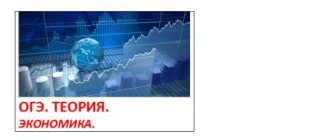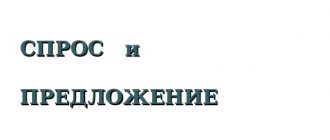Test with answers on the topic: “Supply and Demand”
1. The equilibrium price in a market economy is the price of coincidence: a) supply and demand + b) production and consumption c) production and sales
2. The purchase of which goods is an example of rational consumer behavior: a) the most popular b) good quality at affordable prices + c) the most frequently advertised
3. The price of a product will decrease if the supply of the product: a) decreases and demand remains unchanged b) remains unchanged and demand increases c) remains unchanged and demand decreases +
4. The growth of household savings is primarily facilitated by: a) an increase in wages and pensions + b) a deterioration in the quality of goods and services c) a decrease in unemployment
5. How will the buckwheat market change after an abnormally hot summer: a) the market price of grain will decrease b) the demand for grain will decrease c) the supply of grain will decrease +
6. The value of competition for society is that it: a) helps reduce the number of employees b) leads to a more complete and efficient use of resources + c) initiates privatization processes in the economy
7. According to the law of demand, other things being equal: a) at a low price it is possible to sell fewer goods than at a high price b) the quantity of goods sold depends not so much on the price as on their quality c) at a low price it is possible to sell more goods than at high +
8. An increase in demand for skateboards will occur if: a) successful advertising of skateboards takes place b) the supply of skateboards increases c) the tax for ski manufacturers becomes lower
9. The law of demand states: a) traders offer more goods at high prices than at low prices b) the economic relationship between quality, price and consumer demands c) there is an inverse relationship between demand and price for goods (or services) +
10. Choose the correct statement: a) a change in prices changes the quantity demanded for a product b) a change in prices does not change the quantity demanded for a product + c) buyers will buy goods at high prices if the goods are of poor quality
11. How does the law of demand work: a) the volume of demand decreases in proportion to the increase in the price of a product or service + b) volume does not express the relationship between price and value c)
12. How does the law of demand work: a) volume does not express the relationship between price and cost b) volume demand increases in proportion to the increase in the price of a product or service + c) volume demand increases in proportion to a decrease in the price of a product or service
13. How does the law of demand work: a) volume expresses the relationship between price and cost + b) volume of demand increases in proportion to the decrease in the price of a product or service c) volume of demand increases in proportion to the increase in the price of a product or service
14. Factor influencing the growth of demand: a) level of production technologies b) availability of alternative goods c) growth in consumer incomes +
15. Factor that does not affect the increase in demand: a) subsidies + b) availability of resources c) amount of resources
16. Factor that does not affect the increase in demand: a) seasons b) tax charges + c) fashion
17. General factors influencing supply and demand: a) fashion trends b) seasonality c) market size +
18. Choose the correct definition for the term “Economic demand”: a) a request from a possible buyer to purchase a product or service b) the quantity of a product that can be purchased at the offered price + c) a request from a seller to purchase any type of trade offer
19. The law of “Market supply” in economics states: a) demand increases supply without affecting the price b) supply and demand are not related c) the higher the price of the product, the higher the volume of goods +
20. Factors that influence the economic supply: a) fashion trends b) level of technology + c) level of profitability of the buyer
21. Choose the correct definition for the term “Offer”: a) the desire and ability of the manufacturer (seller) to sell their goods or services at certain market prices + b) the activity of traders in selling their products on the market c) the behavior of the manufacturer of goods on the market
22. Demand for a given product may change if: a) the price of raw materials changes b) the price of a substitute product changes + c) the price of this product changes
23. What can affect the supply of cars: a) fuel prices b) demand for land c) metal prices +
24. Which goods are absolutely inelastic in price (demand): a) luxury goods b) goods that have no substitutes + c) complementary goods
25. In what situation will the equilibrium price of a product increase: a) when supply increases by a greater amount than demand b) when demand increases by a smaller amount than supply c) when demand increases by a greater amount than supply +
26. With the same change in supply and demand, the price of a product: a) increases b) remains unchanged + c) decreases
27. When a new tax is introduced on a product: a) the supply of this product decreases + b) the quantity of supply decreases c) the demand for it increases
28. A situation in which the amount of supply exceeds the amount of demand is called: a) shortage of goods b) overproduction c) excess of goods +
29. What is necessary to satisfy your needs: a) goods + b) resources c) goods
30. Inflation and unemployment are inherent in: a) a centralized economy b) a market economy + c) a traditional economy



